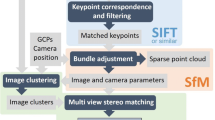Abstract
Several approaches can be used to define and construct visual buffer strips around proposed new facility sites in a forested environment. A visual buffer strip of a given value, defines a region around an object within which the probability of an unblocked view of all or portions of it by an observer are less than the buffer strip probability value. Two primary approaches are used to define visual buffer strips that take into account the size of the vegetative elements and their individual effects on visibility. Several variations and combinations of the approaches are possible. One approach defines a visual buffer strip based on the average probability of a clear view of points along the object by an observer; the other approach is based on the visibility of the feature as a whole. The computation and construction of visual buffer strips based on these two concepts are presented. Comparisons of the two approaches for specific feature shapes are also described.
Similar content being viewed by others
Literature Cited
Amidon, E. L., and G. H. Elsner. 1968. Delineating landscape view areas ... a computer approach. USDA Forest Service Research Note PSW-180, Pacific Southwest Forest and Range Experiment Station, Berkeley, California.
Anderson, L., J. Mosier, and G. Chandler. 1979. Visual management support system.In Our national landscape: A conference on applied techniques for analysis and management of the visual resources. USDA Forest Service General Technical Report PSW-35, Pacific Southwest Forest and Range Experiment Station, Berkeley, California.
Avery, T. E. 1967. Forest measurements. McGraw-Hill Book Company, New York.
Feller, W. 1971. An introduction to probability theory and its applications, vol. 2. John Wiley & Sons, New York.
Miller, S. C., and A. E. Stevenson. 1973. A survey of computergraphics for use in landscape architecture. Report ATR-74 (7426)-1. The Aerospace Corporation, Washington, DC.
Mykelestad, E., and J. A. Wager. 1976. PREVIEW: Computer assistance for visual management of forested landscapes. USDA Forest Service Research Paper NE-355. Northeast Forest Experiment Station, Upper Darby, Pennsylvania.
Rau, J. G., and D. C. Wooten. 1980. Environmental impact analysis handbook. McGraw-Hill Book Company, New York.
Spurr, S. H. 1952. Forest inventory. Ronald Press, New York.
Tlusty, W. 1979. The use of VIEWIT and perspective plot to assist in determining the landscape visual absorption capability.In Our national landscape: A conference on applied techniques for analysis and management of the visual resource. USDA Forest Service General Technical Report PSW-35. Pacific Southwest Forest and Range Experiment Station, Berkeley, California.
Travis, M. R., G. H. Elsner, W. D. Iverson, and C. G. Johnson. 1975. VIEWIT: Computation of seen areas, slope, and aspect for land-use planning. USDA Forest Service General Technical Report PSW-11/1975. Pacific Southwest Forest and Range Experiment Station, Berkeley, California.
Author information
Authors and Affiliations
Rights and permissions
About this article
Cite this article
Rasmussen, W.O. Two methods to define and compute visual buffer strips in a forested environment. Environmental Management 16, 389–396 (1992). https://doi.org/10.1007/BF02400078
Issue Date:
DOI: https://doi.org/10.1007/BF02400078




